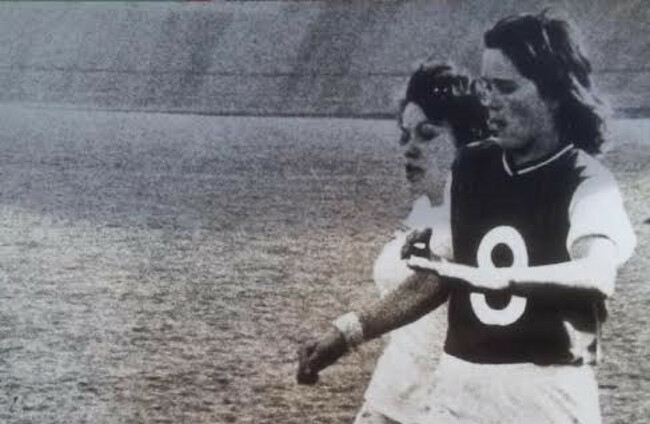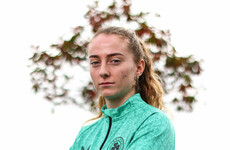IT SAID MUCH that when Anne O’Brien died in 2016, it was international news.
There was some minor coverage in the Irish media but much more detailed reporting in other countries.
In Italy, various outlets paid tribute. One Lazio site prefaced the news with ‘one of our eagles has flown to heaven’. In Trani, the southern fishing town where she won a Scudetto and an Italian Cup, a local journalist, Franco Caffarella, was emotional as he described her talents.
“She had class and she had vision,” he said.
“She was a pure talent who illuminated Italian women’s football. Now she’s a star in the sky.”
Her death was heavily covered in Sweden too.
At the time, Pia Sundhage – an iconic figure in the women’s game and who was in charge of the US side between 2008 and 2012 – was manager of the Swedish national team. Her and Anne had met in the mid-80s, when Sundhage spent a season with Lazio. She was stunned when informed of her former team-mates’ passing.
“Has she gone? I had no idea,” she said.
She wasn’t so much older than I was. Oh, my God. I didn’t know. We actually lived together for a while – five girls in an apartment. Anne was friendly, helpful and always had a smile on her face. Before I learned Italian, I spoke some English so it was pretty easy to talk to her. She was always helpful in translating from Italian when our trainer Sergio Guenza spoke so quickly! She was the kind of midfielder that ran and ran and ran. But she had great technique too. She was quick and always worked for everyone else.”
She’d been in Italy for four decades, her journey an inexplicable and remarkable one.
“She started playing football from a very young age, on the road in Inchicore,” says Tony O’Brien, Anne’s brother.
“She was about 14 when she played for a team called Julian Vards and they played out of Donore Avenue or around that area. She got her first football boots around that time, when my Mam finally gave in and bought her a pair.”
After that, she joined the All-Stars who were based in Ballyfermot. It was a team made up of girls from all around Dublin. She won everything with them for a few years and it was through them that she was spotted, really. In the summer of 1973, she was called up to an Ireland Selection team. The game was against Stade de Reims from France who were on a tour of the country. She was only 17 at the time but afterwards they asked her to travel and play with them for the rest of the Irish tour. And after that it was all done really quickly.”
The deal was historic. No female player from the UK or Ireland had ever played professionally in Europe before.
Anne O’Brien was a revolutionary figure.
Her manager in France was Pierre Geoffroy, a revolutionary figure in his own right and who had assembled the side along with Richard Gaud in the late-1960s, when there was still a ban in place preventing women from being pro footballers. It was 1970 when the authorities lifted that barrier and Gaud would later comment that despite some misogynistic remarks at the very start of the rebirth, people were amazed by the standard of play. Within a couple of years, a few thousand would turn up to championship games and the club used their new-found fame to begin touring and spreading the word.
“Geoffroy felt it was the beginning of something,” Gaud said last year, as Stade de Reims celebrated 50 years since the formation of the women’s team.
“But it was the players who really took their destiny into their own hands, they wanted something and they did it. What was basically just entertainment became the beginning of a beautiful story.”
Anne was a crucial part of the narrative. Bowing to her mother’s demands, she waited until she turned 18 before moving to the north-western city, about 90 minutes drive from Paris. She was big news but seemed completely unfazed by both the move and the attention.
“She was in all the papers,” Tony says.
“It was on the news over here but then she was on ITN in London and obviously it was all covered in the French newspapers too. It was huge.”
In one pun-heavy report from March 1974 (‘Anne, belle of the ball’), she was described as the team’s ‘goalscoring sensation’, earning a reported £100 per week and with ‘fringe benefits like a glass of champagne before each match, and another at half-time – just to add a sparkle to the game.’
“I started playing when I was two years old – as soon as I could walk,” she told reporter Michael Brown, who watched her score against nearby Mourmelon the previous day.
“I left my boyfriend behind to take this big chance and they have been wonderfully friendly and kind.”
Her impact on the team was immediate and she would win three successive French championships between 1974 and 1976. Her performances were so impressive that she was selected for a French League XI for a game against a Rest of Europe side at the end of her debut campaign.
“My Ma was in France with her and there are lovely photos of the two of them walking the streets of Paris together,” Tony says.
“She was after winning the French Cup and was after scoring a hat-trick in that game. Her face was all over the billboards. They called her ‘Nanou’, a nickname that was probably derived from Anne. And there were trips all over the world to play games too. She was in places like Guadeloupe and Haiti and those matches were watched by thousands of fans.”
Back in Dublin, the family didn’t carry much worry or anxiety. They felt it was Anne’s destiny of sorts.
“She always knew she’d end up in football,” Tony says.
“She never wanted to do anything else. In those days, you got on with it no matter what you did. People went on their different journeys all over the world. Everything was pretty straightforward and off she went to France. But we knew Anne and that it would be her for the rest of her life. Because football was her life. It was all she did and all she ever wanted to do.”
In 1976, history repeated itself. Stade de Reims went on a tour to Italy at the end of the season and Anne quickly became a transfer target for Lazio. Their offer of full-time football was too good to turn down so, still aged just 20, she headed for Rome.
“The money was much better in Italy,” Tony says.
“She was always happy there because it was Rome and she loved it. That was her home, really.”
At the end of her first season in the capital, she picked up a Coppa Italia medal after Lazio beat the reigning champions Milan in a shootout. And in 1979, she was a league winner as the Biancocelesti claimed the Scudetto for the first time. The following year, they did it again.
Anne was a classic number 10 and part of an immensely-talented side that also boasted the prolific Danish striker Susanne Augustesen and distinguished defender Maura Furlotti.
“I would’ve been over a lot to watch her and it was brilliant,” Tony says.
“The matches were packed out and the way they did it over there was that if it was a big game like the semi-final of the cup, they’d have the women on before a men’s fixture so everyone would be in the ground and it would nearly be full capacity for the last part of the women’s match.”
It was brilliant to be there and to see her on the pitch. I know she was my sister but, my Jesus, she was a brilliant player. She was way better than half of them over in Italy. She nursed the ball and she fed the ball. She fed everyone everything. A great passer, great control, great technique. Brilliant at taking the ball down from the air. Dribbling. Crossing for the forwards. Then, bang! Back of the net! And isn’t it a pity that we don’t have any videos of her playing? There might be something out there but it’s probably like trying to find a needle in a haystack. There could have been a fella taping a men’s game and even caught the final few minutes of a women’s fixture. But maybe we’ll never know.”
During the 1982/83 season, Anne was persuaded to leave Rome and headed for the west coast along with Augustesen to sign for seaside club Trani. She certainly had excellent timing because despite ending the season as runners-up, the side still claimed an Italian Cup before returning in 1984 and winning the championship. It was Anne’s third Scudetto in eight years.
She did return to Lazio briefly and racked up another Coppa Italia while she was there but despite inching towards her 30s, she remained in demand. There were stints in Modena, Napoli and Prato and while at the former, she gave birth to a son, Andrea.
“She was back playing straightaway,” Tony says.
“I’m sure it was four weeks later that she was playing for the team again. And she used to breastfeed Andrea in the dressing room.”
Later, there was further success with Reggiana and Milan and when Anne finally called it a day in 1994, she’d accumulated five Scudetti with four different teams. It was an astonishing haul.
But, despite being one of the finest players in Europe for two decades, she only ever played four times for Ireland. Once she left for France in the mid-70s, it was a financial and logistical inconvenience for her to be named in squads. So, regardless of her relentless success, she was effectively ignored.
“She would always come back in the summer and every Christmas too,” Tony says.
“In conversations in the house she would talk about it. But there was always a money element involved in those days with the Irish women’s team. There was very little to go around and I’m not sure if there was even much given to the players. If I remember correctly, around 1980 there was a story about them having to pay their own way to Wales or Scotland. The trip was only subsidised and not fully covered. Anne played a lot for Ireland when she was younger and on one occasion they did fly her home for a game against the Netherlands.”
But Italy was her home. Now, she called Dublin home too but that was really her home and Andrea is still over there. 40 years of her life were spent there. It’s where she died and we were all with her at the time. And it’s just a pity that she didn’t stay around a little bit longer…”
Anne did her coaching badges and had stints at two of her former clubs – Milan and Lazio – while she also worked with the Italian Football Federation. Later, she concentrated on coaching local youngsters close to her home by the beach in Fregene, about 40 minutes outside Rome.
The family remain immensely proud of everything Anne achieved in her life and Tony, especially, is an encyclopaedia when it comes to his sister’s career. He’s kept every medal, every newspaper clipping, every photograph. He reels off names and addresses that date back more than 40 years.
“She went away when she was 18 and she died at 60 – what a life,” he says.
“And the Irish girls now are at the top clubs – Arsenal, Liverpool, some are in America. That’s great to see. It’s lovely, isn’t it? The world has changed for the best and it’s getting better. Anne would be delighted and very proud. But she was always proud.”
Subscribe to our new podcast, The42 Rugby Weekly, here:
















What an absolute legend, brilliant article.
A fascinating read on a real pioneer. Great article.
Wonderful Article , never heard of her , tbh
But what a talent , shame she only got 4 caps
Great Article…Ann the legend from Inchicore..Dublin
Great article Eoin, My only gripe is ‘More Please’!
White Pearl Of Inchicore. Can’t believe never knew of her before. RIP Anne
Wonderful! Such a prolific talent
Incredible story. An Irishwoman we should all know more about. Excellent article.
The only artical that iv’e ever read from start to finish on the Journal. What a special girl, what a special brother. She was and is a star.
Wow, a trailblazer for certain.
Very interesting article, wonderful player RIP Anne
Great article. Such a lovely tribute from the 42. The pride and love of the brother comes through so vividly. More of this. RIP Anne.
What an absolute legend of Irish sport.
Great job Eoin on an amazing trailblazer for Irish Sport. Knew a fair bit about her but still discovered something new & loved the pics – the one with her mum is fantastic.
Great tribute to a fantastic sports person its a pity it was not done during her life
Anne was a brilliant sports woman. I recall her participation in athletics and basketball in Oblates Inchicore. She was so down to earth and friendly a legend.